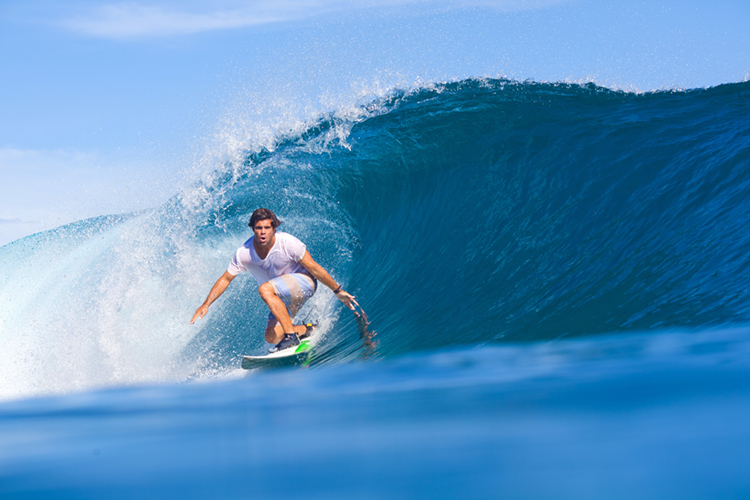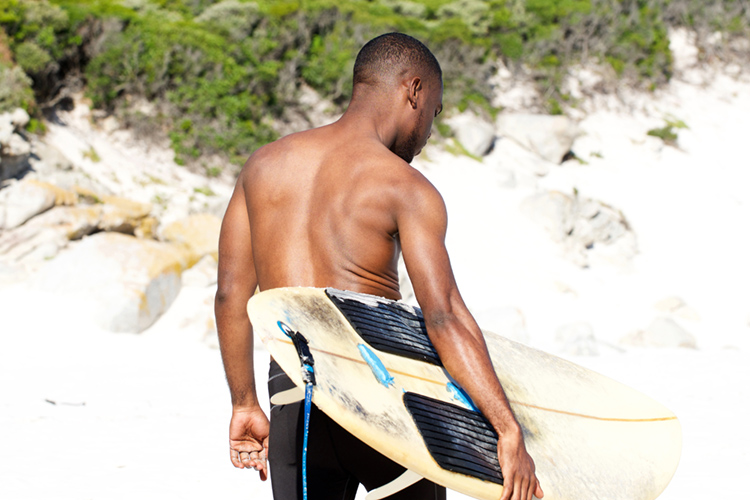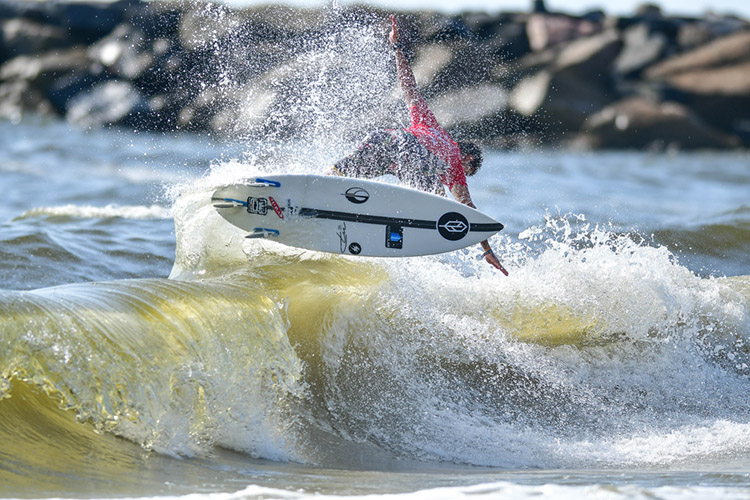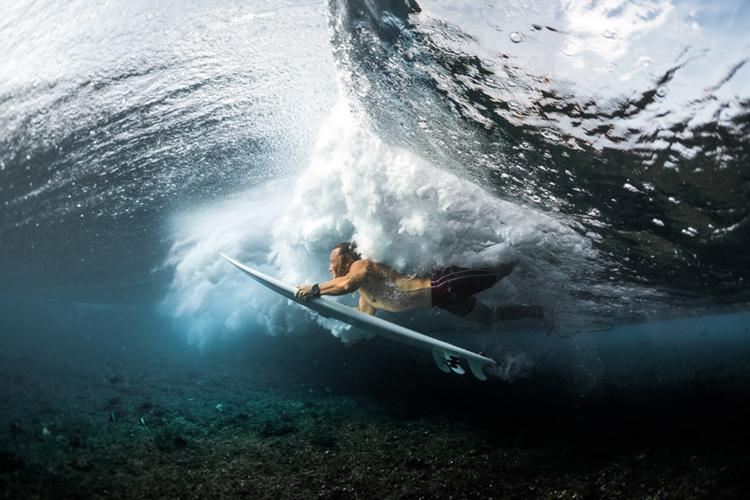The surf industry is one of the fastest-growing action sports industries in the world and is worth around $10 billion.
Surf companies sell exciting, idyllic, and adrenaline-fueled surfing experiences, and they're highly successful in doing it.
The reason why surfing became a multimillion-dollar sports industry is that brands appeal to consumers' emotions and dreams in a very effective way.
Whether inviting you to "stay high" or "live the search," corporate surfing makes you believe "life's better in boardshorts."
And it could be, as long as these giant conglomerates continue selling clothing, footwear, and accessories.
With the advent of Olympic surfing and wave pools, the sport of riding waves will likely continue to conquer new markets and segments of the population that have never had contact with surfboards.
The surf industry is what it is, and surfing wouldn't be what it is today without the innovations and technologies companies have developed during the sport's first century of existence.
Are you looking for a dream job in the surf industry? Think twice.
Why? Because you'll not surf more than you already do, and because the business of surf is just like any other - disappointment may be felt.
Here's what the surf industry doesn't tell you and why it is not as blue as the ocean waves.
Surfing is a Clothing Business
Rip Curl, Quiksilver, Billabong, and O'Neill - also known as the Big Four - focus their marketing plans on selling clothing, i.e., t-shirts, jackets, pants, sweatshirts, flannels, hoodies, tanks, and boardshorts.
That's their core business and how they pay shareholders. Everything else is peanuts.
Boardshorts Are Not Rocket Science, But Their Price Flies High
Boardshorts are very popular among surfers. Despite being reasonably easy to produce, they can be as expensive as $200.
Why? Marketing strategists sell you innovative stretch fabrics, revolutionary water-repellent coatings, and super comfortable outseams for the price of a beginner surfboard.
You could ask: what are they made of? Simple: polyester and elastane.

Surfboard Making is a Highly Pollutive Activity
The environmental impact associated with surfboard shaping is a disaster.
The truth is that all materials involved in the production of surfboards are toxic, not only to humans but also to the planet's ecosystem.
Everything in this field - from polyurethane to resins used by shapers - is dangerous.
Surfboard Manufacturers Outsource Child Labor
The surfboard business is not a highly lucrative activity, and all costs must be cut to a minimum.
Therefore, the largest surfboard manufacturers have been outsourcing their production lines to countries where child labor persists, including Thailand, China, and Taiwan.
Surf Wax is Toxic
Ninety-five percent of all surf wax blocks sold worldwide contain petrochemical additives, solidifying chemicals, high-strength bleach, and paraffin.
So, surf wax is basically a petroleum-based product that will do more harm than good to your health and will cause damage to the oceans and marine life.
An alternative solution? Make your own wax.
Black Surfers Don't Get Sponsors
When was the last time you saw a black surfer competing professionally at the highest level, in a Championship Tour (CT) or even Qualifying Series (QS) event? Probably Michael February.
And that's it. So, are there any black athletes capable of embracing a career as pro surfers? Yes, but they don't get sponsorship deals.

Only Youth Sells Surfing
Have you ever seen a magazine ad, TV, or video commercial featuring a 45-year-old surfer getting barreled at Pipeline?
When was the last time you saw a 39-year-old female world surfing champion featuring in a web banner ad and promoting a bikini? Probably never.
Why? Because you don't sell a cool outdoor lifestyle using adults.
Tanning Is Unhealthy, But Corporate Surfing Doesn't Care
It may look good, but scientists proved that there's a direct connection between ultraviolet radiation and skin cancer. There is no such thing as a healthy or safe tan.
Tanning leads to premature skin aging, wrinkles, eye damage, and a weakened immune system.
Nevertheless, surf brands continue to include tanned surfers in their marketing actions.
Sunscreens Are Harmful to Marine Life
Unfortunately, there are no sunscreens 100 percent safe for corals, reefs, and marine life. It has been proved that oxybenzone and octinoxate - two of the most common ingredients in chemical sunscreens - decrease corals' defenses against bleaching.
In the medium term, and especially on crowded beaches, when sunscreens get in touch with the water, they will damage and eventually kill coral reefs.
White, Tanned and Sexy: The Profile of the Highest-Paid Female Surfers
With stunning bodies, white smiles, and millions of followers on social media, only white Caucasian female surfers get a chance to ink a six or seven-figure sponsorship deal.
The majority of women pro surfers who don't fit in the babe-and-model stereotype will not earn a living from riding waves.

Free Surfers Are a Marketing Tool
The world's most famous free surfers are nothing but athletes that are very well paid not to compete.
Instead, they chase swells, embark on more or less secret surf missions, and participate in exclusive boat trips.
Surf companies use these charismatic individuals with exotic personalities to sell the sense of freedom experience that surfing is supposed to give.
Their legendary dreadlocks, hipster longboard styles, and blasé looks help to sell the dream better.
Pro Surfing is a Lucrative Business
The professional surfing circuit has always been a business like any other. It is run by executives - surfers and non-surfers - whose only goal is to make money.
They work with sponsors, event promoters, and consumer brands to create value from viewers, spectators, and fans.
The World Surf League (WSL) even charges membership fees to athletes wanting to compete in official, WSL-sanctioned events.
Only America, Europe, and Oceania Buy Surf Products
Surf companies focus their operation on three major territories: America, Europe, and Oceania. That's where they get over 90 percent of their annual income.
So, it will always be difficult to find a surf shop with a full range of surf-related accessories in Africa and Asia. It's just not worth it.
Surf Is Where the Money Is
Do you want to run a surf contest on your home break?
Have you ever wondered why surf contests aren't run in places and regions where waves are perfect nearly all year round?
Well, local organizers have to invest a lot of money to run the show.
And sometimes, they're forced to get the competition underway even with poor ocean conditions.

Big Wave Surf Spots Rival With Each Other
Big waves have a huge magnetic economic power.
Not only do they attract surfers and media professionals eager to ride and witness Nature's raw power, but they also seduce anonymous people who just want to photograph the largest wave in the world.
When Garrett McNamara broke the Guinness World Record for the biggest wave ever surfed, he shifted the attention from the established big wave arenas of Peahi/Jaws, Ghost Tree, Mavericks, Cortes Bank, and Nelscott Reef to Nazaré's Praia do Norte.
Initially, and for nearly a month, American surf media tried to silence the Portuguese big wave surfing break.
Why? Because there was a lot (of money) at stake.
Non-Governmental Organizations (NGOs) Run by Surfers Have Constrained Agendas
They were founded to save waves from extinction, clean the ocean, and protect beaches and coastal communities.
But the truth is that surfing-related NGOs are funded by more or less glamorous entities and their private agendas.
If not, how is Bali's plastic pollution different from Hawaii's microplastic issues? And why do they get treated differently by global NGOs?
Sixty Percent of Wetsuits Are Produced in the Same Factory
Believe it or not, the majority of the world's wetsuits are made in the same place.
Taiwan's Sheico Group produces two million wetsuits per year for the planet's most prestigious surf companies.
So, don't expect huge differences between neoprene models from rival wetsuit brands.
Sodas, Alcoholic and Energy Drinks, and Diesel-Powered Cars Sponsor Pro Surfing
Surfers may project a healthy image, but some of the sponsors behind them are not helping the cause.
The ASP World Tour had Coke/Coca-Cola and Foster's; the World Surf League brought Corona, Red Bull, and Jeep into the game.
Is there a chance of having a mineral water company backing pro surfing?
Marijuana is Quietly Taking Over Surfing
Ever since marijuana became mainstream in the United States, it's okay to smoke pot and enter a surf contest.
At least, that's what Weedmaps is doing on the North Shore of Hawaii.
They bought a house at Pipeline and made it a local dispensary. So, it seems that in the near future, smoking a joint will be as conventional as having a beer.
Sustainable Surf Products Don't Sell
Top surf brands use sustainable surf wear and gear as a marketing tool to make them look greener.
But the truth is that their few eco-friendly products are not (and probably will never be) best-sellers because they're too expensive, and nearly no one buys them.
Wave Pools Are an Energy Consumption Catastrophe
Make no mistake: the first generation of wave pools is an energy-intensive industry.
And only high-energy costs explain the price you have to pay to surf an artificial wave.
Surfing is supposed to be a near-zero carbon emission footprint, but the future still doesn't look bright.
